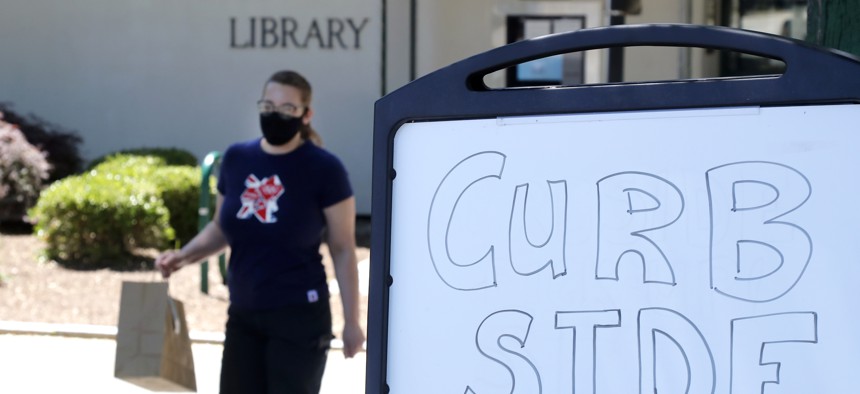Libraries Begin Partial Reopening as Covid-19 Cases Surge

Librarian Emily Giguere delivers books to a reader waiting in his car outside the Haverhill Library, Wednesday, June 17, 2020, in Haverhill, Mass. Libraries are closed for interior use due to coronavirus concerns. Associated Press
Most libraries are implementing phased reopening plans, beginning with contactless pickup of materials that undergo a quarantine period for safety.
Nearly four months after closing its branches, the Columbus Metropolitan Library is reopening—sort of.
“We were about to roll out fuller public access, where we would have all locations open for people to come in and sit and so forth,” said Alison Circle, chief customer experience officer for the 23-branch library in Ohio’s capital. “But given the increase in Covid-19 cases here, and the numbers on the pandemic, we have decided to slow that pace.”
For now, the library will continue to offer contactless pick-up of books and movies at the curb outside the library, as well as “limited public access” for patrons who want to visit branches to pick up items or use computers, fax machines and scanners. Masks are mandatory and online and virtual programming will continue, Circle said.
“Everything is difficult, but for now, we’re fine, in that our customers are largely deeply understanding and grateful,” she said. “Almost all of the comments I hear from customers are that they’re really happy to be able to access the library again, in whatever way they can.”
That access varies widely from place to place, as states and municipalities grapple with the complicated task of reopening during an ongoing pandemic. Some libraries, including the Wheaton Public Library outside of Chicago and eight branches in New York City, will soon begin offering “grab and go” services, giving patrons access to a limited area to return or pick up materials. The Brown County Library in central Wisconsin is open for computer use by appointment only, while the Sitka Public Library in Alaska plans to welcome patrons but enforce a “no lingering” rule as well as close three days per week for extended cleaning.
In many places, library staff are also implementing quarantine periods for books to help ensure safety for patrons. Those guidelines are largely based on the results of a study, released last week, that found that the SARS-Cov-2 virus, which causes Covid-19, is “undetectable” on books and DVD cases after three days.
In Columbus, materials are grouped in bins labeled with the date and time of their return and left to sit for 72 hours. After that, they’re checked in and reshelved as usual. The only hiccup so far, Circle said, is helping customers understand why a book or movie remains “checked out” on their account when they’ve already returned it.
“We just try to explain that we’re quarantining it,” she said. “We haven’t had late fees since 2015, but it’s hard to get over that long-held tradition of being charged.”
Reopening plans, and the services they entail, depend on a library’s size and location, as well as the state of the pandemic, which changes daily and varies in different parts of the country. (Cases have spiked nationwide in the past two weeks, according to federal data, though a handful of states have fared better.)
But typically, those plans have followed a phased approach, often beginning by bringing staff back to the facilities, then moving to curbside, contactless pickup of physical materials, said Curtis Rogers, a spokesman for the Urban Libraries Council. As of Wednesday, 140 of the council’s 159 member libraries were offering some form of sidewalk or curbside service.
“During initial phases, customers are often not allowed into the library buildings themselves—though some libraries do offer limited indoor services in early phases, such as by-appointment computer access,” he said. “Later stages in library reopening plans begin to welcome people back into buildings in greater numbers, but often with restrictions such as metered access or reduced hours. In the final stages of reopening their buildings, full on-site services and hours will be in place as libraries adjust to their ‘new normal.’”
But it’s unclear when libraries might return to pre-pandemic levels of service. Only 37% of libraries had plans to reopen by July, and 47% percent were unsure when their branches might begin welcoming patrons back inside, according to a May survey from the American Library Association.
But virtual programming, including online story hours and ebook lending, continues. Many of those initiatives, along with curbside pickup, are likely to persist long after the pandemic has passed, Circle said.
“We started doing live story hours on Facebook, for example—and it’s not the same experience, I give you that—but before, you might speak to 20 kids, and now, we’re speaking to 2,500 kids,” she said. “I think a lot of the things we’ve stood up are going to stay. Why would we take away a service the customers are enjoying?”
Kate Elizabeth Queram is a staff correspondent for Route Fifty and is based in Washington, D.C.
NEXT STORY: It's Time for Governors to Get Tough with Coronavirus Again





